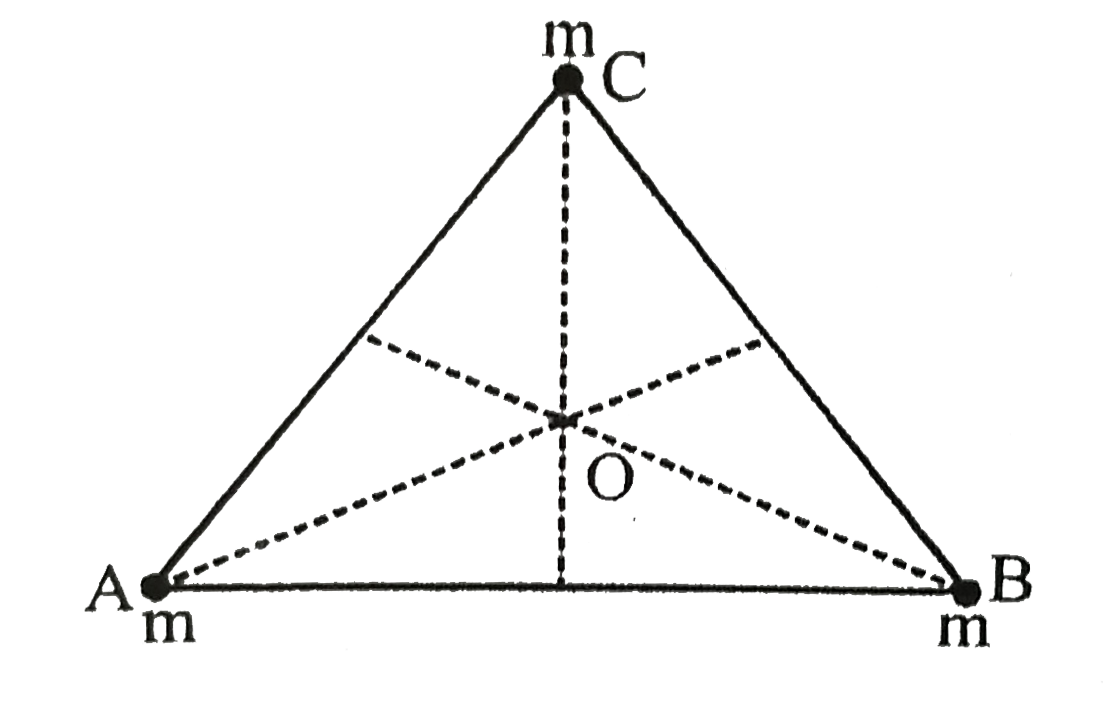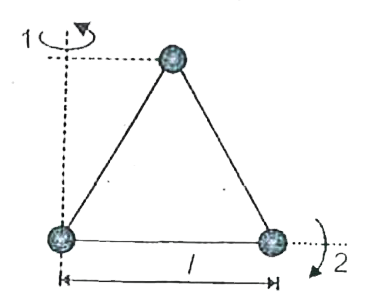Three identical bodies (each mass M) are placed at vertices of an equilateral triangle of arm L, keeping the triangle as such by which angular speed the bodies should rotated in their gravitional fields so that the triangle moves along circumference of circular orbit :
√3GML3
√GML3
√GM3L3
3√GML3
The correct Answer is:A
To solve the problem, we need to determine the angular speed (ω) at which three identical bodies, each of mass M, must rotate around the center of an equilateral triangle formed by their positions, such that the triangle moves along the circumference of a circular orbit.
1. Understanding the System:
We have three identical bodies placed at the vertices of an equilateral triangle with side length L. Each body experiences gravitational attraction due to the other two bodies.
2. Centripetal Force Requirement:
For the triangle to move in a circular path, each body must experience a centripetal force that keeps it in circular motion. The centripetal force (F_c) required for a body of mass M moving in a circle of radius r with angular speed ω is given by:
Fc=Mω2r
3. Finding the Radius:
The distance from the center of the triangle to any vertex (the radius r) can be calculated as:
r=L√3
This is derived from the geometry of the equilateral triangle.
4. Gravitational Force Between the Bodies:
The gravitational force (F_g) between any two bodies of mass M separated by a distance L is given by Newton's law of gravitation:
Fg=GM2L2
where G is the gravitational constant.
5. Net Gravitational Force on One Body:
Each body experiences gravitational attraction from the other two bodies. The net gravitational force acting on one body due to the other two can be calculated. The effective force can be found using vector addition, resulting in:
Fnet=√F2g+F2g−2FgFgcos(120∘)=√F2g+F2g+F2g=√3Fg
Thus,
Fnet=√3⋅GM2L2
6. Setting the Forces Equal:
For the triangle to maintain its shape and rotate, the net gravitational force must equal the required centripetal force:
Mω2(L√3)=√3⋅GM2L2
7. Simplifying the Equation:
Cancel M from both sides (assuming M ≠ 0):
ω2L√3=√3⋅GML2
Rearranging gives:
ω2=3GML3
8. Finding Angular Speed:
Taking the square root to find ω:
ω=√3GML3
Final Answer:
The angular speed at which the bodies should rotate is:
ω=√3GML3 radians per second
We have three identical bodies placed at the vertices of an equilateral triangle with side length L. Each body experiences gravitational attraction due to the other two bodies.
For the triangle to move in a circular path, each body must experience a centripetal force that keeps it in circular motion. The centripetal force (F_c) required for a body of mass M moving in a circle of radius r with angular speed ω is given by:
Fc=Mω2r
The distance from the center of the triangle to any vertex (the radius r) can be calculated as:
r=L√3
This is derived from the geometry of the equilateral triangle.
The gravitational force (F_g) between any two bodies of mass M separated by a distance L is given by Newton's law of gravitation:
Fg=GM2L2
where G is the gravitational constant.
Each body experiences gravitational attraction from the other two bodies. The net gravitational force acting on one body due to the other two can be calculated. The effective force can be found using vector addition, resulting in:
Fnet=√F2g+F2g−2FgFgcos(120∘)=√F2g+F2g+F2g=√3Fg
Thus,
Fnet=√3⋅GM2L2
For the triangle to maintain its shape and rotate, the net gravitational force must equal the required centripetal force:
Mω2(L√3)=√3⋅GM2L2
Cancel M from both sides (assuming M ≠ 0):
ω2L√3=√3⋅GML2
Rearranging gives:
ω2=3GML3
Taking the square root to find ω:
ω=√3GML3
The angular speed at which the bodies should rotate is:
ω=√3GML3 radians per second
Topper's Solved these Questions
- BOOK - ALLENCHAPTER - GRAVITATIONEXERCISE - EXERCISE 226videos
GRAVITATION
- BOOK - ALLENCHAPTER - GRAVITATIONEXERCISE - EXERCISE 311videos
GRAVITATION
- BOOK - ALLENCHAPTER - GRAVITATIONEXERCISE - BOX-414videos
GRAVITATION
- BOOK - ALLENCHAPTER - GEOMETRICAL OPTICSEXERCISE - subjective14videos
GEOMETRICAL OPTICS
- BOOK - ALLENCHAPTER - KINEMATICS-2DEXERCISE - Exercise (O-2)48videos
KINEMATICS-2D
Similar Questions
Three identical point objects each of mass m are placed at the vertices of an equilateral triange of side l. What is the gravitational potential at the centre of the equilateral triangle due to the point masses?
View SolutionThree identical particles each of mass m are placed at the vertices of an equilateral triangle of side a. Fing the force exerted by this system on a particle P of mass m placed at the

(a) the mid point of a side
(b) centre of the triangleView Solution
Knowledge Check
- Question 1 - Select One
Three particle each of mass m are placed at the corners of equilateral triangle of side l

Which of the following is/are correct ?AMoment of inertia about axis '1' is 54ml2BMoment of inertia about axis '2' is 34ml2CMoment of inertia about an axis passing through one corner and perpendicular to the plane is 2ml2DAll of these - Question 2 - Select One
Three identical bar magnets each of magnetic moment M are placed in the form of an equilateral triangle as shown.
 AZeroB2MCM√3D3M2
AZeroB2MCM√3D3M2 - Question 3 - Select One
Three particles each of mass m are kept at vertices of an equilateral triangle of side L. The gravitational field at centre due to these particle is
AzeroB3GML2C9GML2D12GM√3L2
Three charges each20μC are placed at the corners of an equilateral triangle of side 0.4m The potential energy of the system is
View SolutionThree identical charges are placed at the vertices of an equilateral triangle. The force experienced by each charge, (if k=14πε0) is
View SolutionThree particles each of mass m are kept at the vertices of an euilateral triangle of side L. The gravitational field at the centre due to these particle is
View SolutionThree particles each of mass m are kept at the vertices of an euilateral triangle of side L. The gravitational field at the centre due to these particle is
View SolutionThree identical masses, each of mass 1kg, are placed at the corners of an equilateral triangle of side l. Then the moment of inertia of this system about an axis along one side of the triangle is
View Solution

